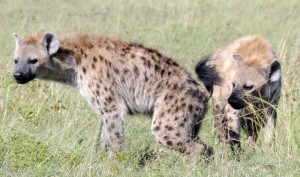We have seen animals like dogs, cats and others squatting to mark their territorial borders and to pass other messages. Researchers have been trying to unravel the amount of messages these signs flash to other animals. A similar study lead by postdoctoral researcher Kevin Theis of Michigan State University, has revealed some important information about hyenas squatting also known as pasting. The study mainly focused on two species of hyenas namely the spotted hyenas and the striped hyenas.
Hyenas have scent a gland contained in a pouch found just over the anus, discharging a yellowish secretion known as the “paste” and has a pungent odor. The place is ideal for bacterial growth being warm, moist and supported by ample of food. The bacteria ferments the food derived from the skin thus producing the smell. Researchers have found bacteria in this paste playing a pivotal role in hyena’s communication. Earlier the bacterial identification from the collected samples were limited as it was not possible to grow all bacteria in culture, but now with the new genetic sequencing techniques more bacteria has been analyzed so far. Theis found that the varied bacterial composition is the key in producing diverse odor, making it easy for hyenas to differentiate among varied social groups and strangers, among individuals of same family, sex and state of reproduction.
When presented with the collected samples of paste, the hyenas easily distinguished if the sample belongs to a male or a female hyena. This paste even provide information whether the female is ready for mating or is pregnant or is in lactating period. Hyenas even identified whether a member of same clan or a stranger produces the paste.
It has been observed that young hyenas also imitate the procedure of squatting over the twig of grasses; however, they can only produce the paste after reaching puberty. Theis believes this helps the young ones to cover themselves with the odor of the clan they belong. Moreover male hyenas of 2-5 years of age has to move to other groups and so has to quickly adapt to the odor of their new social group by hoisting new composition of bacteria.
The study was specific to hyenas but the researchers believe such bacteria might also play similar role in other animals as well and providing even more information about the emotional and mental state of the animal. The research has way to go in understanding the signals communicated through these odor.




